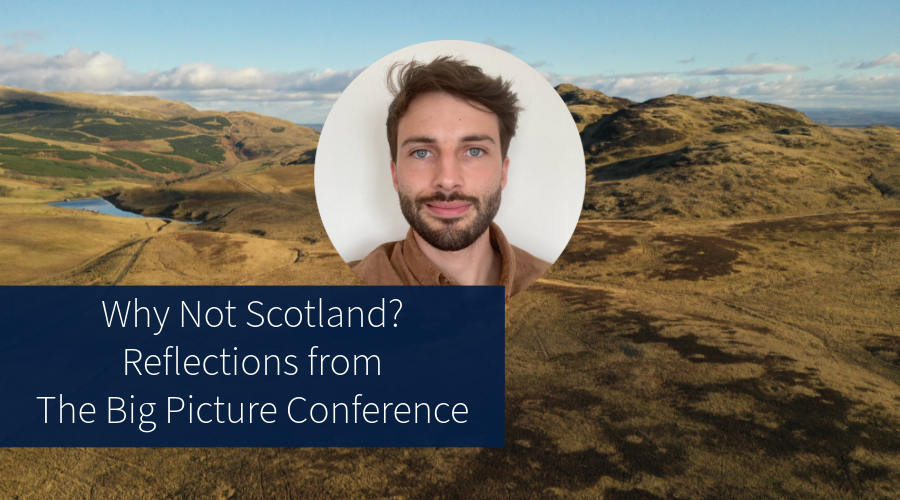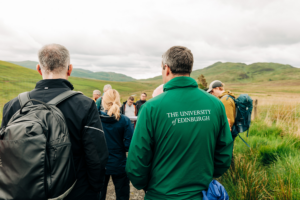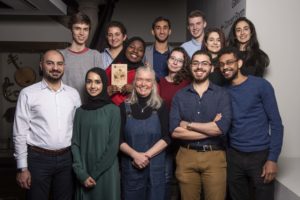Why Not Scotland? Reflections from The Big Picture Conference 2024

Pete Baker, Business Development Executive – Nature & Biodiversity at the University of Edinburgh, reflects on conference highlights, leading expertise and the University’s role in innovation.
The 2024 Big Picture Conference brought together a diverse group of individuals united by a shared commitment to nature recovery. This year’s theme, “Why Not Scotland?”, emphasised Scotland’s potential opportunity to become a global leader in nature restoration, setting new standards for biodiversity recovery and sustainable ecosystems.
The Big Picture Conference 2024
What is nature restoration?
Humans have been shaping the environment since our species first emerged. A recent study suggests that early humans may have caused a decline in large mammals in Eastern Africa, one of the earliest instances of environmental impact. Over the past four million years, humans have continued to monopolise resources, leading to severe environmental degradation.
Study: Brain expansion in early hominins predicts carnivore extinctions in East Africa
No ecosystem has been spared from habitat loss, agricultural intensification, over consumption, urban expansion, and invasive non-native species. Scotland exemplifies this, with the Biodiversity Intactness Indicator showing that Scotland has retained just over half of its historic land-based biodiversity, ranking it in the bottom 25% of nations.
Faced with these challenges, how can we improve the state of nature in Scotland? Nature restoration offers a solution that could benefit both people and nature. It attempts to increase the biodiversity of degraded habitats by removing human pressures and allowing natural processes to return. This can be as simple as reducing grazing pressure to enable the natural regeneration of shrubs and forests.
The idea is that nature will re-colonise these habitats, delivering beneficial outcomes for local biodiversity. While this approach can work in practice, it is important to note that nature left to its own devices does not always produce the best outcomes for biodiversity. Therefore, nature restoration is another form of human landscape management, but with the focus on improving, rather than degrading, the state of nature.
Nature restoration also offers an alternative economic model for rural Scotland, allowing existing communities and landowners to benefit from the transition to more natural habitats. For example, at Dundreggan in Inverness, since the charity’s purchase of the former deer stalking estate in 2008, jobs have increased from one to 36, while volunteer numbers have risen from zero to 100. The development of robust natural capital markets could also contribute to the financial viability of nature restoration projects, such as Dundreggan.
The reality of nature restoration is nuanced, with many social, political, and environmental considerations at play. Recent cuts to NatureScot’s Nature Restoration Fund and slowing demand for natural capital highlight that the policy and funding landscape for nature restoration is facing an uncertain period.
Conference highlights
Despite the challenges, the Scotland Big Picture Conference speakers offered a pathway through the uncertainty.
The conference brought together a diverse range of voices in nature restoration. Speakers highlighted key issues around sustainable land management, ecological grief, and species reintroduction. Christopher Preston discussed successful wildlife recoveries, while Mary Colwell addressed the emotional impact of ecological loss. Dr. Duncan Halley mentioned the key factors that determine successful species re-introductions, with a focus on lynx in Norway as a case study.
The conference encouraged attendees to envision a more biodiverse Scotland, where nature and people could thrive together. This point was emphasised by Peter Cairns, director of Scotland: The Big Picture. Peter highlighted the importance of taking a step back from the polemic debates surrounding nature restoration, and instead focusing on the wide array of benefits that restoring nature can bring to both the environment and society.
The University of Edinburgh’s role

Staff visit the Forest & Peatland programme sites (credit: University of Edinburgh)
The University recognises our responsibility to lead on the acceleration of biodiversity loss. The University strives to find scalable solutions to the ecological crisis, understanding that long-term, whole-system, multidisciplinary approaches are essential to understand and resolve the complexities and inter-dependencies surrounding this issue.
To signal the University’s intent to find solutions, in October 2021, the University launched a long-term, multi-million-pound project to restore peatlands and expand forests in Scotland. This project aims to remove carbon from the atmosphere, increase biodiversity, connect woodlands, improve recreation and scenery for local communities, and preserve cultural heritage sites. Through this initiative, the University will sequester its unavoidable carbon emissions, produced by essential travel, as part of its ambition to be zero carbon by 2040.
The University owns 887 hectares of land across three areas outside Edinburgh as part of this programme. In doing so, we are attempting to create a unique platform for place-based research, teaching and innovation on climate, biodiversity, and related issues. This move builds on our exceptional research expertise in this domain, and on our location in Scotland, where the opportunities for nature restoration the associated community benefits are abundant. Through our partnerships with local communities and organisations like NatureScot, we have already seen tangible improvements in the population of rare plants, with species such as the sticky catchfly increasing due to these efforts.
The initiative will provide a natural laboratory for research, teaching, and innovation activity at a landscape scale. It will allow observations, modelling and prediction of the natural environment, and human interaction with it, over decades and it will be a living lab for testing and demonstrating solutions to climate mitigation, enhancement of biodiversity, and just transitions at scale.
The Forest and Peatland programme
The role of innovation
To realise these plans, the University will need to partner with others who have similar vision and goals, and with complementary resources and expertise. Three themes underpin the University’s strategic approach to this commensurate challenge.
Ecological monitoring, measurement, and verification
To begin the process of halting biodiversity loss and starting nature restoration, we first need to understand the current state of nature across as many ecosystems and habitats as possible. Although this is a complex and challenging task, new tools and methods are being developed to overcome some of these barriers and allow us to gain this important baseline understanding. For example, the University’s Airborne Research and Innovation facility, with support from the School of Informatics, recently conducted a study using drones and machine learning to understand the impact of Avian Flu on Bass Rock.
The results were the first known application of deep learning to detect dead birds from drone imagery. This consortium, with The Scottish Seabird Centre and the UK Centre for Ecology and Hydrology, shows the value of collaborative research and innovation in measuring and monitoring techniques and underpins how new techniques can help improve monitoring of time intensive techniques in sensitive areas. This could prove to be a valuable tool for conservation tools worldwide.
Ecological restoration
In areas where we have a strong understanding of the drivers of biodiversity decline or where robust monitoring has uncovered them, we need to choose the appropriate restoration and management actions. These can range from technical to sociological interventions, both of which are crucial to ensure success. Technical interventions are needed to physically alter the current environment, such as afforestation and peatland restoration. For example, Dr. Nicholle Bell in the School of Chemistry focuses her research on understanding the most impactful interventions in peatland restoration, ensuring that existing efforts have their desired impact.
Another good illustration of where our academic expertise is driving impact on biodiversity decision making is Dr Janet Fisher in the School of GeoSciences, who recently co-authored the Restoration Partnership Development Toolkit, which helps nature restoration projects navigate the complex stakeholder engagement process often involved in rural communities.
Green finance and natural capital
Once the causes of biodiversity loss have been identified and robust solutions selected, these must be implemented. The key question is: how do we fund nature restoration in our current economic system? Public funding has traditionally filled this gap, such as through NatureScot’s Nature Restoration Fund. However, funding from the private sector will need to increase if we are to meet the scale of the issues. Craig Mackenzie, Senior Lecturer in Sustainable Enterprise, summarised the state of the green finance market in a series of LinkedIn posts analysing the pension, insurance and philanthropy sectors.
We want to set new standards in biodiversity recovery by combining scientific expertise with practical solutions, creating a sustainable future for ecosystems both in Scotland and worldwide. The University of Edinburgh can help you understand the root causes of biodiversity loss, implement solutions that effectively address these causes, and integrate these outcomes into our current economic system to ensure financial viability and long-term sustainability.
How Edinburgh Innovations can support you
Edinburgh Innovations (EI) is the University’s commercialisation service. We connect academic expertise with real-world challenges to drive innovation and impact through collaboration.
Our Business Development colleagues are embedded in most Schools and Research Institutes, and help researchers at any stage to apply their research to the world’s greatest challenges. They are the first points of contact to identify and develop translational and industrial funding and opportunities. Our Consultancy Managers provide support to generate proposals, the negotiation of contracts, invoicing and legal protection. Our Enterprise Services team helps University staff and students take their ideas from concept to real-world impact. The team’s work includes the validation, protection, development and commercialisation of inventions and intellectual property.
Access the support and resources available to help you realise ambitions for your research – unlocking innovation to make ideas work for a better world.
- Contact EI – If you have an idea and want to drive innovation from your research, meet the team ready to support you on your innovation journey.
- Take the next step with Engage – EI’s online learning programme focuses on the ‘how to’ of external engagement and a practical first step in collaborating with external organisations.
- Sign up to our Unlocking Innovation newsletter – Be inspired by our innovators, discover the support and resources available to you and celebrate the latest innovation success stories.





Recent comments